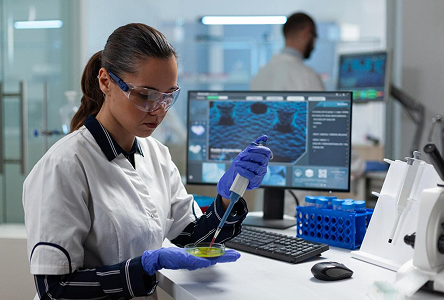For growing life science startups, flexibility is everything. Whether advancing early-stage discoveries or preparing for preclinical validation, the ability to scale without disruption often determines how quickly science progresses from concept to impact.
A scalable wet lab provides that flexibility, enabling research teams to increase capacity without the financial or logistical strain of relocating. By tapping into shared resources, startups can focus on scientific milestones instead of real estate headaches.
So, what does this kind of lab flexibility really enable? Let’s break down the core benefits that help early-stage teams scale smarter and faster:
Expanding Capabilities Without Disruption
Traditional lab build-outs take months, require major investment, and involve regulatory hurdles. Flexible wet lab environments let teams scale immediately adding bench space and equipment without construction delays or relocation downtime.
Why it Matters:
- Researchers keep experiments running instead of pausing for facility upgrades.
- New team members and equipment can be added without interrupting workflows.
- Avoids unexpected build-out costs (e.g., permits, utilities, HVAC retrofits).
- Maintains alignment with deadlines, grant commitments, and investor expectations.
Accessing Specialized Equipment on Demand
From fully equipped sterile tissue culture facilities to advanced analytical instrumentation, access to specialized equipment is often what determines research velocity. Our flexible wet lab environment eliminates the need for costly equipment purchases by providing shared access to validated, high-end tools that individual startups or investigators might not otherwise afford. The facility includes a flow cytometer, qRT-PCR system, fluorescent microscopes, plate readers, centrifuges, and ultra-low temperature freezers. In addition, researchers have convenient access to our histology core services, which feature automated tissue processors and stainers, as well as digital pathology platforms—all available without the need for long-term capital investment.
Why it Matters:
- Provides immediate access to complex equipment needed for milestone-driven projects.
- Reduces the financial burden of purchasing and maintaining underutilized systems.
- Ensures instruments are validated, maintained, and ready for use by trained staff.
- Enables small teams to generate high-quality data at the same technical standard as larger biotech labs.
Scaling in Sync with Milestones
Growth in life sciences rarely happens in a straight line. A scalable lab model lets startups expand or contract as funding, hiring, and research priorities shift without being locked into long-term leases or oversized facilities.
Why it Matters:
- Aligns operating costs with project phases and grant or investor timelines.
- Prevents underutilized space during early phases or overcrowding during scale-up.
- Supports smooth transitions from proof-of-concept to preclinical development.
- Gives teams flexibility to respond to new opportunities without logistical setbacks.
Keeping Science Moving Forward
In research, progress depends on more than scientific insight, it depends on the infrastructure that supports it. When lab space is adaptable, teams avoid the bottlenecks caused by traditional facility upgrades or relocations, keeping experiments and timelines on track from proof-of-concept through scale-up.
Why it Matters:
- Prevents project delays during space transitions or equipment changes.
- Ensures continuity for complex workflows that rely on uninterrupted lab access.
- Reduces the risk of data loss or rework due to infrastructure-related downtime.
- Supports reliable timelines for hitting scientific milestones tied to grants, partnerships, and funding rounds.
Leveraging Core Facilities and Expert Support
Maintaining a fully equipped wet lab is resource intensive. A recent analysis by Harvard biostatistician Rafael Irizarry estimates that supporting a 20-researcher lab can cost a university up to $8 million per year in facilities, equipment, compliance, IT, and operational support—far more than most early-stage companies can justify investing.¹
Shared lab environments bridge this gap by giving researchers access to specialized core facilities such as histology, imaging, flow cytometry, or cell culture along with trained staff who help execute and optimize complex workflows. In environments like ours, that means hands-on access to state-of-the-art tissue processing, staining, and digital pathology systems, supported by expert staff who streamline workflows and accelerate results. This model empowers startups to tap into advanced capabilities without the burden of managing equipment, personnel, or capital investments in-house.
Why it Matters:
- Reduces the learning curve for complex, high-stakes techniques.
- Replaces costly equipment ownership with access-as-needed.
- Ensures quality and consistency through validated, standardized workflows.
- Helps teams move faster from experimental design to data interpretation.
- Allows budget to be allocated toward science not infrastructure.
How HistoSpring Puts This Model Into Action
At the Baystate Research Facility, teams can start with affordable coworking bench space and expand into additional benches or private labs as their projects and funding evolve. With shared equipment, concierge-style support, and proximity to leading academic research centers, HistoSpring offers startups a collaborative environment where they can scale quickly, access specialized tools, and get expert workflow assistance—from assay setup to data analysis.
In Summary
A flexible lab model enables life science startups to stay focused on research, move quickly from idea to execution, and make smarter use of capital. It’s not just about lab space—it’s about creating a launchpad for scientific and commercial growth.
The flexible model makes it possible to:
- Scale research capacity without capital-intensive buildouts.
- Run complex workflows using shared high-end instrumentation.
- Sustain project continuity without infrastructure-related downtime.
- Align operating costs with project milestones and funding cycles.
To learn more about flexible wet lab space and how it can support your growth, contact us at labresources@histospring.com or 413-794-0523 or visit HistoSpring.com.
References
- Irizarry R. Universities Do Spend Indirect Costs on Research, And It’s Still Not Enough. Simply Statistics, Feb. 17, 2025. https://simplystatistics.org/posts/2025-02-17-universities-do-spend-indirect-costs-on-research-and-its-still-not-enough/.
#WetLab #LabSpace #LifeScienceStartup #BiotechStartups





















